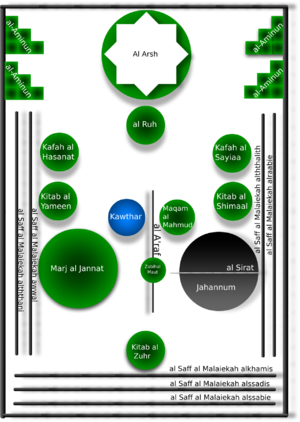Religion:Pond of Abundance

In Islam, the Pond of Abundance or Pool of Kawthar (Template:Lang-ar-at[2]) refers to a pond or river that exists in Paradise. The traditional Muslim belief is that on the Day of Judgement, when people will be resurrected, they will rise in great thirst and be eager to quench it in an atmosphere of chaos. Then, Muhammad would be the one privileged by God to respond to the pleas of believers to quench their thirst by offering them a cool and refreshing drink from the pond.
Origin of the concept
The Quran refers to the situation in Surah Al-Kawthar, but several exegetes maintain that the reference in the Surah is to the general abundance granted to Muhammad.[3][4] In any case, the concept has come to be identified with the special reverence for Muhammad in comparison to other Prophets and Messengers of God.
This concept also exists in Christianity in John 7:37–38.[5]
On the last day of the festival, the great day, while Jesus was standing there, he cried out, “Let anyone who is thirsty come to me, and let the one who believes in me drink. As the scripture has said, ‘Out of the believer’s heart shall flow rivers of living water.’”.
Implications
The pond's general implication is that it motivates Muslims to be conscious of the Day of Judgement and its severity and accordingly to plan to improve their afterlife. It also motivates them towards love of Muhammad and promoting the view that the events around the Day of Judgement require belief in the unseen and are highly metaphysical in nature.
See also
- Islamic view of the Last Judgment (Akhirah)
- Islamic eschatology (Qiyamah)
References
- ↑ Begley, Wayne E. The Garden of the Taj Mahal: A Case Study of Mughal Architectural Planning and Symbolism, in: Wescoat, James L.; Wolschke-Bulmahn, Joachim (1996). Mughal Gardens: Sources, Places, Representations, and Prospects Dumbarton Oaks, Washington D.C., ISBN:0884022358. pp. 229–231.
- ↑ Houtsma, M. Th. (1993). E. J. Brill's First Encyclopaedia of Islam, 1913-1936. BRILL. p. 835. ISBN 90-04-09790-2. https://books.google.com/books?id=7CP7fYghBFQC&pg=PA835.
- ↑ Tadabbur-i-Quran by Amin Ahsan Islahi - exegesis available here
- ↑ Exegesis by Javed Ahmad Ghamidi
- ↑ "John 7:37 on the last and greatest day of the feast, Jesus stood up and called out in a loud voice, "If anyone is thirsty, let him come to Me and drink". https://www.biblehub.com/john/7-37.htm.
 |

